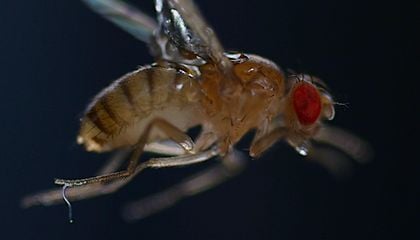Science
Parasitic Worms Harness Static Electricity to Board Fruit Flies

Research from the University of California, Berkeley has unveiled an intriguing mechanism by which parasitic worms known as nematodes use static electricity to attach themselves to fruit flies. This groundbreaking study, published in the journal Science Advances in April 2024, highlights the unexpected interaction between these tiny organisms and their insect hosts.
The experiment showcased how nematodes, which measure only a few millimeters in length, can effectively utilize electrical charges to increase their chances of survival and reproduction. When fruit flies come into contact with surfaces carrying a static charge, the nematodes are able to “hop” onto their unsuspecting hosts. This behavior not only facilitates their transportation but also allows them to find new environments in which to thrive.
Previous research indicated that nematodes employ various strategies to infect their hosts, primarily through physical contact or environmental cues. The new findings introduce a novel method that relies on the physics of static electricity, demonstrating a sophisticated level of adaptation. The researchers utilized high-speed cameras to capture the dynamic process, revealing that the nematodes perform rapid jumps when they detect the right conditions near the flies.
The significance of this study extends beyond the fascinating behavior of nematodes. Understanding how these parasites interact with their hosts can provide insights into their life cycles and ecological roles. Moreover, it can inform strategies to manage the populations of these pests, which have implications for agriculture and public health.
Lead researcher, Dr. Maria Garcia, emphasized the importance of this discovery: “We are witnessing a remarkable example of how even the smallest organisms can manipulate their environment to their advantage. This research opens doors to new approaches in controlling pest populations.”
In addition to its ecological implications, this research raises questions about the potential uses of static electricity in biological systems. The findings encourage further exploration into how static electricity can be harnessed or mitigated in various contexts, including crop protection and pest management.
The study not only highlights the remarkable adaptability of nematodes but also serves as a reminder of the intricate relationships within ecosystems. By examining these connections, scientists can better understand the balance of nature and the ongoing challenges posed by parasites in both agricultural and natural settings.
As researchers continue to explore these interactions, the implications for pest management and ecological balance remain a critical area of study. The fascinating behaviors exhibited by these tiny worms reveal the complexity of biological systems and the innovative strategies organisms employ to survive and thrive in their environments.
-

 World5 days ago
World5 days agoExposing the Reality Behind Guatemala’s Garment Industry
-

 Politics5 days ago
Politics5 days agoLB Pharmaceuticals Quiet Period Ends October 21, Analysts Weigh In
-

 World5 days ago
World5 days agoHamas to Return Remains of Additional Hostage on Friday
-

 Business5 days ago
Business5 days agoRoyal Bank of Canada Upgrades Ovintiv to Outperform Rating
-

 Sports5 days ago
Sports5 days agoSaquon Barkley Reflects on James Franklin’s Dismissal from Penn State
-

 Lifestyle5 days ago
Lifestyle5 days agoSouth Los Angeles Intersection Renamed to Honor Activist Danny Bakewell Sr.
-

 Entertainment5 days ago
Entertainment5 days agoSylvester Stallone’s ‘Alarum’ Surges in Streaming Despite Poor Reviews
-

 Health5 days ago
Health5 days agoFDA Announces First Nine Recipients of National Priority Vouchers
-

 Science5 days ago
Science5 days agoMIT Develops 3D Brain Models from Patient Cells for Custom Therapies
-

 Entertainment5 days ago
Entertainment5 days agoOlivia Nuzzi’s Memoir Set to Uncover RFK Jr.’s Controversial Texts
-

 Lifestyle4 days ago
Lifestyle4 days agoHistorian Seeks Help to Uncover Cherry Street’s Past
-

 Science3 days ago
Science3 days agoYale School of the Environment Launches Accelerated Master’s Programs









